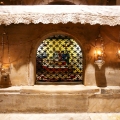The Great Zimbabwe, a sprawling stone complex located in southeastern Zimbabwe, stands as one of Africa’s most extraordinary historical sites. Constructed between the 11th and 15th centuries by the ancestors of the Shona people, this UNESCO World Heritage Site reflects a legacy of architectural ingenuity, cultural significance, and spiritual resonance.
An Architectural Marvel
The Great Zimbabwe is characterized by its imposing stone walls, which were built without mortar, a technique known as dry-stone masonry. Its most iconic structure, the Great Enclosure, is a massive elliptical wall that measures 250 meters in circumference and rises up to 11 meters high. The site also includes the Hill Complex, perched atop a granite outcrop, and the Valley Ruins, spread across the surrounding landscape. These structures suggest a sophisticated urban layout, blending defensive strategies, ceremonial spaces, and residential areas.
The site’s name, derived from the Shona term “dzimba dza mabwe,” meaning “houses of stone,” underscores its monumental nature. The construction reflects the ingenuity of the Shona civilization, showcasing their mastery of engineering and aesthetic design.
Pilgrimage and Spiritual Significance
The Great Zimbabwe was not just a political and economic center; it also held deep spiritual importance. Archaeological evidence suggests that the site was a hub for religious ceremonies and rituals, possibly connected to the worship of Mwari, the Shona supreme deity. The Hill Complex, in particular, is thought to have been a sacred space where rituals were conducted to communicate with ancestral spirits or invoke blessings for the community.
This spiritual significance may have made the Great Zimbabwe a pilgrimage destination for neighboring communities. Pilgrims likely journeyed to the site to seek divine favor, participate in ceremonies, or affirm their cultural ties to this majestic center. The effort involved in these journeys would have underscored the reverence in which the site was held, turning it into a focal point for both spiritual and communal gatherings.
Myths and Legends
The Great Zimbabwe’s enigmatic presence has inspired myths and legends over the centuries. Early European explorers speculated wildly about its origins, attributing it to civilizations as diverse as the Phoenicians and the Queen of Sheba. These claims have long been debunked, with historians and archaeologists firmly establishing its construction by the Shona people.
Among local traditions, the site is often seen as a place imbued with ancestral power. Stories speak of spirits guarding the ruins, and the monolithic soapstone bird carvings discovered there are believed to symbolize links between the earthly and spiritual realms. These iconic birds remain an enduring emblem of Zimbabwe, featured on its national flag and currency.
Trade and Cultural Exchange
The Great Zimbabwe was a thriving center of trade, linking Africa’s interior with the Swahili Coast and beyond. Archaeologists have uncovered artifacts such as Chinese porcelain, Arabian glass, and Indian beads, demonstrating the site’s role in global trade networks. This exchange of goods and ideas enriched the cultural fabric of the civilization and reinforced the site’s status as a powerful urban and spiritual center.
A Living Heritage
Today, the Great Zimbabwe continues to inspire awe as a symbol of African heritage and resilience. Visitors to the site are drawn not only by its monumental architecture but also by its deep cultural and spiritual significance. Walking through its massive stone walls and climbing the sacred Hill Complex offers a glimpse into the lives, beliefs, and aspirations of the people who built this enduring marvel.
For travelers, the Great Zimbabwe offers an opportunity to explore the intersection of history, spirituality, and human ingenuity. It stands as a place of pilgrimage where the past speaks powerfully to the present, reminding us of the profound connections between culture, belief, and community.
Abu Simbel: An ancient pilgrimage to the edge of the Egyptian empire





